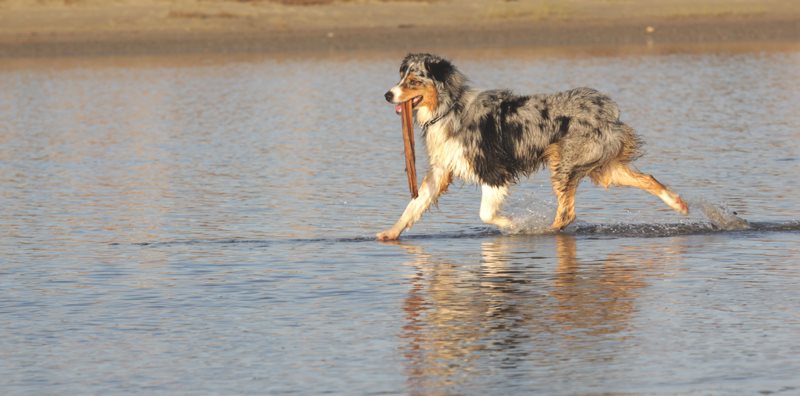|
||
|
(Source : Standard ASCA) Created January 15, 1977: Revised June 01, 2013 INTRODUCTION: First and foremost, the Australian Shepherd is a true working stockdog, and anything that detracts from his usefulness as such is undesirable. The most important breed characteristics are overall moderation in size and bone, balance with correct proportions, and sound movement GENERAL APPEARANCE: The Australian Shepherd is a well-balanced dog of medium size and bone. He is attentive and animated, showing strength and stamina combined with unusual agility. Slightly longer than tall, he has a coat of moderate length and coarseness with coloring that offers variety and individuality in each specimen. An identifying characteristic is his natural or docked bobtail. In each sex, masculinity or femininity is well defined. CHARACTER: The Australian Shepherd is primarily a working dog of strong herding and guardian instincts. He is an intelligent, exceptional companion. He is versatile and easily trained: performing his assigned tasks with great style and enthusiasm. He is reserved with strangers but does not exhibit shyness. This unusually versatile stockdog works with the power and quickness to control difficult cattle as well as the ability to move sheep without unnecessary roughness. Although an aggressive, authoritative worker, viciousness toward people or animals is intolerable. HEAD: The head is clean-cut, strong, dry, and in proportion to the body. The topskull is flat to slightly rounded; its length and width each equal to the length of the muzzle. The muzzle is of medium width and depth and tapers gradually to a rounded tip, without appearing heavy or snipey. Lips are close fitting, meeting at the mouthline. The toplines of the muzzle and topskull appear close to parallel. The stop is moderate but well defined.
Disqualifications: Undershot bite, Overshot bite, Wry Mouth
Faults: Any deviation from almond-shaped eyes.
Severe Faults: Prick ears; overly large ears; low set ears with no lift from the base. NECK AND BODY: The neck is firm, clean, and in proportion to the body. It is of medium length and slightly arched at the crest, setting well into the shoulders. The body is firm and muscular. The topline appears level at a natural four-square stance. The bottom line carries well back with a moderate tuck-up. The chest is deep and strong with ribs well sprung. The loin is strong and broad when viewed from the top. The croup is moderately sloping. The Tail is straight, not to exceed four (4) inches, natural bobtail or docked. FOREQUARTERS: The shoulder blades (scapula) are well laid back, with the upper arm (humerus) slightly longer than the shoulder blade. Both the upper arm and shoulder blade are well muscled. The forelegs are straight and strong, perpendicular to the ground, with moderate bone. The point of the elbow is set under the withers and is equidistant from the withers to the ground. Pasterns are short, thick, and strong, but still flexible, showing a slight angle when viewed from the side. Feet are oval shaped, compact, with close knit, well-arched toes. Pads are thick and resilient; nails short and strong. Dewclaws may be removed. HINDQUARTERS: Width of hindquarters is approximately equal to the width of the forequarters at the shoulder. The angulation of the pelvis and upper thigh (femur) corresponds to the angulation of the shoulder blade and upper arm. The upper and lower thigh are well muscled. Stifles are clearly defined; hock joints moderately bent. The metatarsi are short, perpendicular to the ground, and parallel to each other when viewed from the rear. Feet are oval shaped, compact, with close-knit, well-arched toes. Pads are thick and resilient; nails short and strong. Rear dewclaws are removed. COAT: The coat is of medium length and texture, straight to slightly wavy, and weather resistant. The undercoat varies in quantity with climate. Hair is short and smooth on the head, outside of ears, front of forelegs, and below the hocks. Backs of forelegs are moderately feathered and breeches are moderately full. There is a moderate mane, more pronounced in dogs than bitches. The Australian Shepherd is a working dog and is to be shown with a natural coat. COLOR: All colors are strong, clear and rich. The recognized colors are blue merle, red (liver) merle, solid black, and solid red (liver) all with or without white markings and/or tan (copper) points with no order of preference. The blue merle and black have black pigmentation on nose, lips and eye-rims. Reds and red merles have liver pigmentation on nose, lips and eye rims. Butterfly nose should not be faulted under one year of age. On all colors the areas surrounding the ears and eyes are dominated by color other than white. The hairline of a white collar does not exceed the point at the withers. GAIT: Smooth, free, and easy, exhibiting agility of movement with a well-balanced natural stride. As speed increases, both front and rear feet converge equally toward the centerline of gravity beneath the body. The top line remains firm and level. When viewed from the side the trot is effortless, exhibiting facility of movement rather than a hard driving action. Exaggerated reach and drive at the trot are not desirable. Gait faults shall be penalized according to the degree of deviation from the ideal. SIZE: Preferred height at the withers for males is 20 to 23 inches; that for females is 18 to 21 inches, however, quality is not to be sacrificed in favor of size. Other Disqualifications: Monorchidism and cryptorchidism. |
